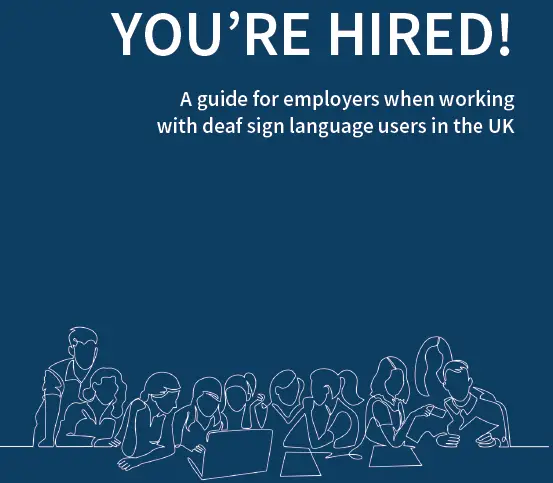Guide for employers working with deaf sign language users
A useful, research-based guide for employers on how to recruit, support and retain deaf sign language users.
Published : 01/06/2019
Home » Guide for employers working with deaf sign language users

Report cover
Download this guide for employers when working with deaf sign language users in the UK
Based on research conducted by the DESIGNS project, funded by the European Commission under the Erasmus+ Programme.
From the Editor’s Note:
“We have adapted this guide for employers based in the UK, who have employees
or are considering engaging employees, who communicate in sign language and
may require the assistance of a sign language interpreters in the workplace.
“The aim of this guide is to offer practical guidance when engaging with sign
language users and working with sign language interpreters. The guide draws on
good HR and communication protocols and considers some of the complexities
surrounding various work-based setting. This guide also considers some cultural
and linguistic aspects arising when interacting with Deaf communities.
“Some of these tips may seem pretty obvious – but we include them because these
are issues that have been identified as stumbling blocks.
“Our DESIGNS research has shed light on examples where sign language users’
rights are compromised due to a lack of understanding of the Deaf community
and the role that interpreters play; insufficient deaf and sign language awareness
training leading to a breakdown of communication. The evidenced-based research underpinning this guide was carried out by a group of experts as part of the
DESIGNS project.
“It must be emphasised that this is a good-practice guide and should not be taken
as a legal protocol, nor should it supersede or compromise your existing internal
procedures. We encourage you to review your existing policies/procedures and
integrate relevant features from this guide as appropriate. Our hope is that this
guide serves as a tool that facilitates professional and/or institutional reflection
regarding good practices when interacting with the Deaf community.”
Watch a scenario of a job interview where the interpreter has not met in advance
In scenario 1, the interpreter has not met with the candidate in advance. The interviewers should be talking to the candidate, not the interpreter. The interpreter’s tone is different.
Link to transcript
When an interpreter has had time to prepare in advance of a job interview
In scenario 2, the interpreter has met with the candidate in advance. The interviewers talk to the candidate, and the interpreter’s tone is different.
Link to transcript
Other related resources
EDICa hosts a regular blog and seminars, as well as collecting a library of resources of equality, diversity & inclusion practices in research & innovation.

Disabled people are missing from Antarctic EDI work: how do we fix it?
Date: 23 May 2024
A guest blog by Alice Oates, a 2023 Scientific Committee on Antarctic Research (SCAR) Fellow.

Disability Access Workshop Recording
Date: 15th March 2024
EDICa hosted Dr Katherine Deane and Dan Burrill from U of East Anglia to speak about making universities more accessible. Recording and slides here.

Enabling NeuroDiverse Inclusive Science Careers
Date: 31st May 2022
Recommendations for how to make science careers more inclusive for neurodivergent researchers.




































